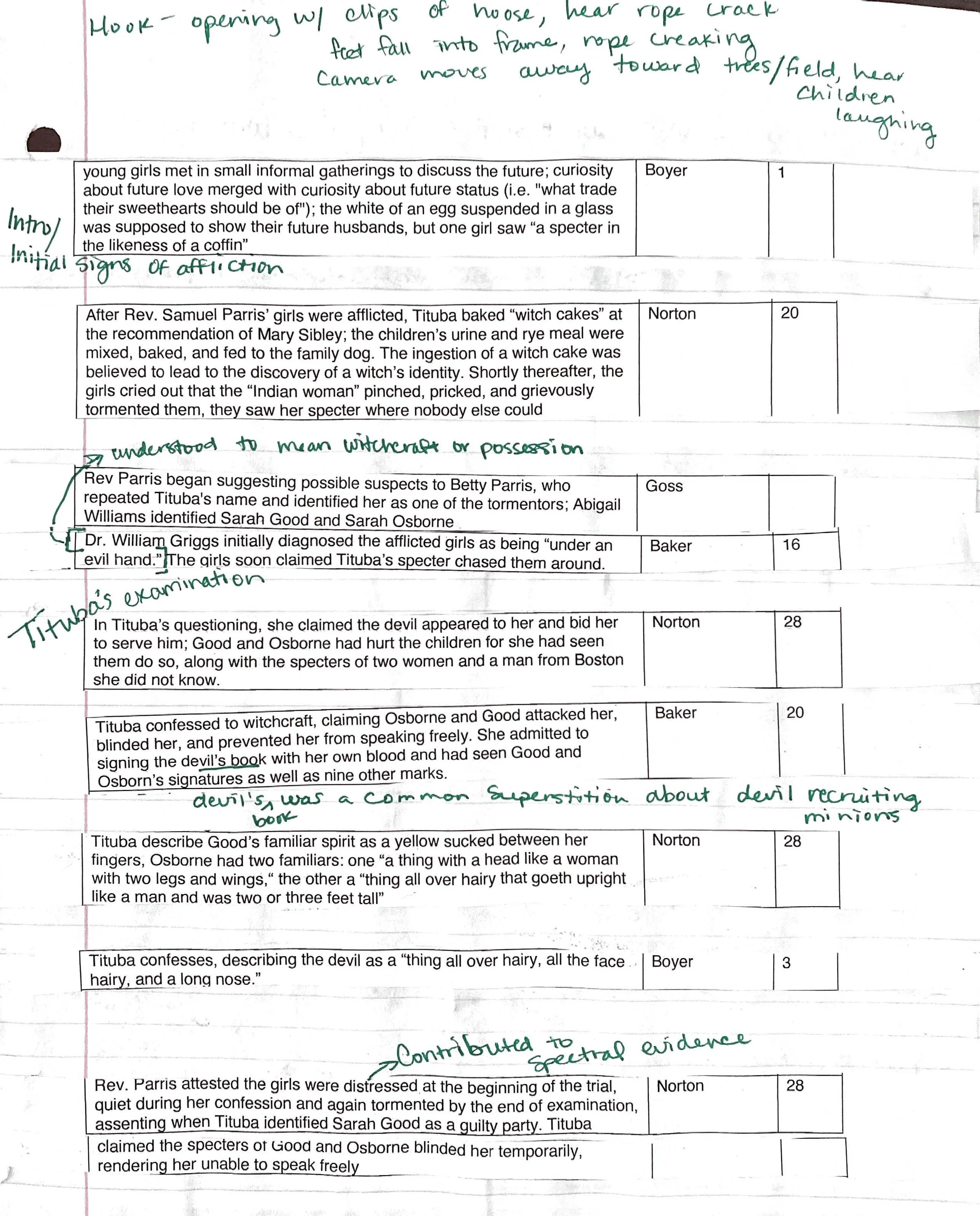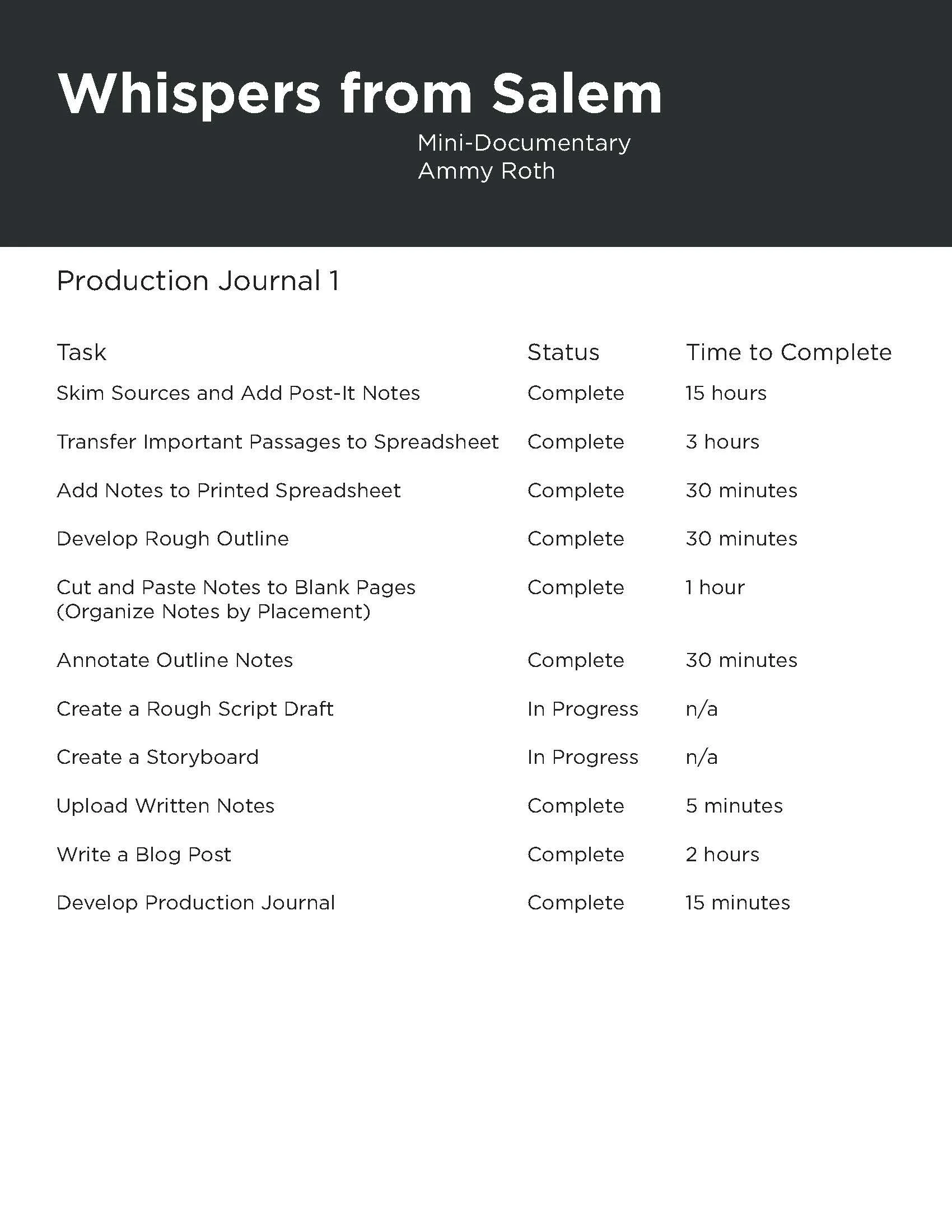Rituals in Research: Developing a Mini-Documentary
Last week, I created a Project Plan for a proposed mini-documentary about the Salem Witch Trials. The Witch Trials are a common topic, but the information often gets mixed up with other colonial witch hunts. In this mini-documentary, I’ve chosen to focus primarily on the use of spectral evidence in witchcraft convictions. Spectral evidence refers to the use of invisible forces harming an “afflicted person” via the specter of a human being. Since only the afflicted persons can see the specters, spectral evidence’s reliability was often debated.
I will be developing this mini-documentary in seven weeks, so creating a project plan helped me get on track to create my dream project with a tight deadline. Within that project plan, I intended to complete several deliverables this week, including Detailed Notes, Rough Outline, Annotated Outline, Storyboard, and a Rough Script. However, in this week’s occurrences, I realized I was too optimistic with my expectations.
The note-taking process took significantly longer than I expected (I planned to complete the heftiest amount of research by Wednesday and didn’t finish until Friday evening). As a result, by the week’s end, I could only create Detailed Notes, Rough Outline, and Annotated Outline. I’m currently working on the Rough Script and will start the Storyboard soon after finishing the Rough Script.
I initially wanted this project to focus on gossip, rumors, and invisible evidence. However, when I read through my first source looking for something interesting to focus my mini-documentary on, I found something even more specific than invisible evidence: spectral evidence. The spectral evidence used to convict witches in Salem Village was primarily gossip and rumors - stories people told about the accused that made them seem wicked or something strange occurring after an unpleasant interaction with the accused.
The Salem Witch Trials were the primary cause for the Massachusetts Bay Colony banning the use of spectral evidence in court proceedings. Accusers could say they saw the “specters” of another person attacking or ailing them and often spoke about dreams where the accused tormented or confessed to them. All of these we know today as hearsay.
While skimming through books, I note relevant passages with a brief description on a post-it note.
To get through as many of the sources in my bibliography as possible, I skimmed through sources, searching for relevant subjects or keywords. Then, for each relevant passage, I wrote a brief description on a post-it note and stuck the note in the book. Once satisfied with the number of sticky notes in my books, I transferred the important passages to a spreadsheet on my computer. I included the author’s name and page number for each note.
Next, I printed out two copies of this note document. On the first copy, I used colored markers to highlight similar information and note important details. I call this document my “Detailed Notes” since it includes information I deemed important from respective sources (even if the information repeats) and the source information (like author and page number).
After creating my Detailed Notes, I used a general three-act story structure to create a “Rough Outline” for my project. The similarities I marked on my Detailed Notes helped me form clusters of information to align in the three-act outline. First, I started with a hook, something to open the story and grab viewers’ attention (see more below). Then, I slowly added each section to the outline.
I cut each passage out of the second copy of the note document and organized them by similarity and placement in the rough outline (i.e., categorized them as General Introduction, Case Examples, Forms of Evidence, etc.). I’m a very hands-on thinker, so this process helps me focus on something that seems more real in the physical world than on my laptop. Then, with these individual strips organized into their respective placements, I started gluing passages to blank sheets of paper and adding relative notes. This might seem like an unnecessary way to copy and paste my notes, but tangible, written notes help me think more clearly and prevent me from using the computer as a distraction.
Finally, I started working on the Storyboard for my project but realized storyboarding this particular project was a little more daunting than previous projects. I wanted to create the Storyboard before the rough script and incorporate key moments from the storyboarding process into the script. However, most of the mini-documentary’s script will be based on the notes in my Annotated Outline. Therefore, I will continue with a rough draft of the script before developing the Storyboard. I also created a Production Journal to help me keep track of completed tasks, tasks in process, and tasks I still need to complete.
Baker, E. W. (2016). A Storm of Witchcraft: The Salem Trials and The American Experience. Oxford University Press.
Burns, M. & Rosenthal, B. (2008, July). Examination of the Records of the Salem Witch Trials. The William and Mary Quarterly, 65(3), 401-422.
Boyer, P. & Nissenbaum, S. (1974). Salem Possessed: The Social Origins of Witchcraft. Harvard University Press.
Chasse, B. (2019). Documentary filmmaking master class: Tell your story from concept to distribution. Skyhorse Publishing Company, Incorporated.
Francis, R. (2005). Judge Sewall’s Apology: The Salem Witch Trials and the Forming of an American Conscience. Harper Perennial.
Goss, D. (2008). The Salem Witch Trials: A Reference Guide. Greenwood.
Latner, R. (2006, March). ‘Here are No Newters’: Witchcraft and Religious Discord in Salem Village and Andover. The New England Quarterly, 79(1), 92-122.
Norton, M. B. (2003). In The Devil’s Snare: The Salem Witchcraft Crisis of 1692. Vintage.
Schiff, S. (2016). The Witches: Suspicion, Betrayal, and Hysteria in 1692 Salem. Back Bay Books.
Wilkman, J. (2020). Screening Reality: How Documentary Filmmakers Reimagined America. Bloomsbury Publishing.
America’s Hidden Stories: Salem’s Secrets. (n.d.). America’s Hidden Stories. Episode. Retrieved from https://www.smithsonianchannel.com/episodes/vpp3he/america-s-hidden-stories-salem-s-secrets-season-1-ep-1.





